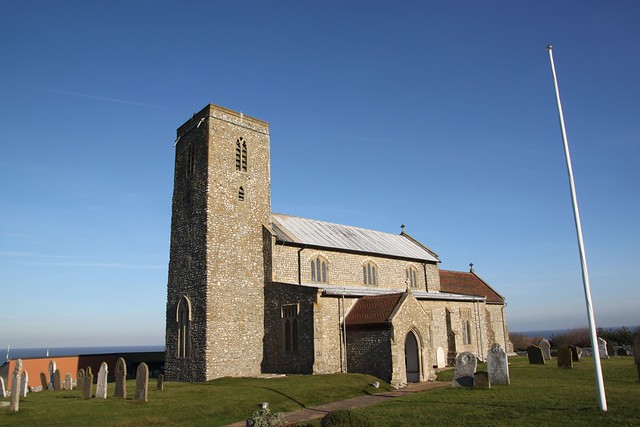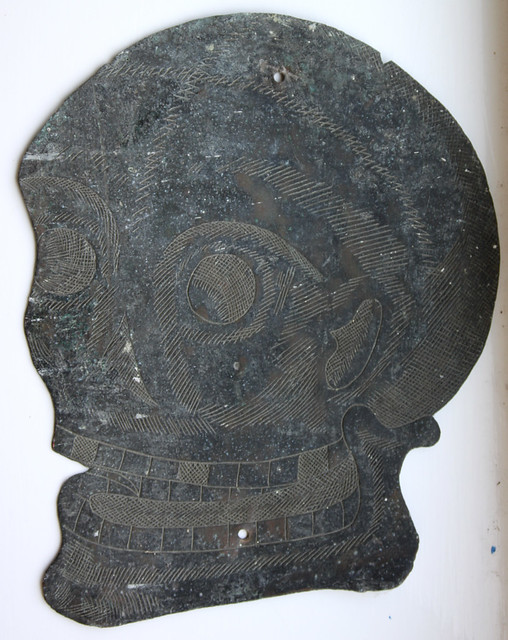Respice, Respice - a lost death's head found.

During my brief time as a parish priest in Norfolk I looked after five churches, including the extraordinary church of All Saints, Beeston Regis. The church sits in open ground on the edge of Sheringham, above the cliff and overlooking the North Sea. It was a bleak and windy spot, which made the many burials in the churchyard an interesting affair to say the least.

It is a beautiful church with much of interest, including a fine rood screen decorated with painted figures of the Apostles. Beyond in the chancel are a number of monumental brasses, including a series of inscriptions and an Evangelist symbol, with others hidden by the timber base of the choir stalls.


The most important of the brasses by far, is that of John Deynes who died in 1527. His brass effigy and that of his wife is now in the centre of the Chancel floor where they were placed in the nineteenth century. Until 1867 they were it seems on top of a tomb chest in the north aisle of the church. In the late eighteenth century Francis Blomefield saw the brasses on a 'monument' in the north aisle, which was decorated with heraldic devices. 'a helmet, a pike and respice'. In John Chambers 1829 'General History of Norfolk', though he gets his Norfolk Beeston's confused, he quotes a source which he calls 'The Complete History of Norfolk, 1730' recording 'a monument for John Deynes and Catherine his wife, with these words engraved on it, RESPICE, RESPICE', which suggests this motto was repeated.

On his brass Deynes is dressed in contemporary civilian attire, but round his neck he has a cord from which hangs a curious object. This object, which looks like a pistol, has been interpreted as a mariner's whistle and on that basis it is assumed that Deynes was a mariner.
In 2012 I was approached by Martin Stutchfield of the Monumental Brass Society, who was then conducting a survey of Norfolk's brasses. He conducted a full survey of the brasses here and at my other church in West Runton. Apparently thirty years previously there had been more brasses in Beeston Regis church, including a curious image of the 'death's head', which hadn't been seen since the 1970s. It was thought lost. He believed that the death's head, formed part of the original ensemble of the Deynes tomb in the north aisle and may even have been the 'helmet' recorded by Blomefield. You can see Martin's write-up here on pages 389-390.

Well I decided to thoroughly search the vestry and thankfully I came up with the goods. The death's head was in an old Jiffy bag stuck behind the vestry wardrobe. It was a wonderful moment to find this object, as it shed so much new light on the Deynes brass and its original context. It is an extraordinary image this death's head, a grinning skull engraved with hatching and cross hatching on a thin metal plate. It is both gruesome and realistic, but also more than a little bit comical to our eyes. In the 1520s when it was engraved it would have been far from comical. In conjunction with the words 'Respice' 'Look', which quite often formed part of the motto 'respice finem' - 'look to', or 'look back to the end' - this death's head was part of a striking memento mori that formed an important part of the Deynes monument as originally conceived.

So the Deynes monument, like so many of the late fifteenth or early sixteenth century was a monument with a complex function that went beyond mere memorialisation. The images of John and Catherine Deynes now isolated from their context, were originally on the top of the monument. They were shown here in life, at their prime - fashionable, well-to-do and in control. While the tomb chest that supported these brasses and covered their own bodies, acted as a mechanism that reminded the viewer, family, friends and neighbours, of the eternal realities. That death sweeps such fineries away and had left John and Catherine Deynes without ultimate control. The Deynes tomb, prior to its dispersal in 1867, was a complex visual construct, a version of the transi tomb.

Comments
I've just got back from Austria. Whilst there I couldn't resist popping into the village church in Scheffau (Tirol). What I found in there 'blew my socks off'. I've just posted some photographs on my blog which you might find interesting